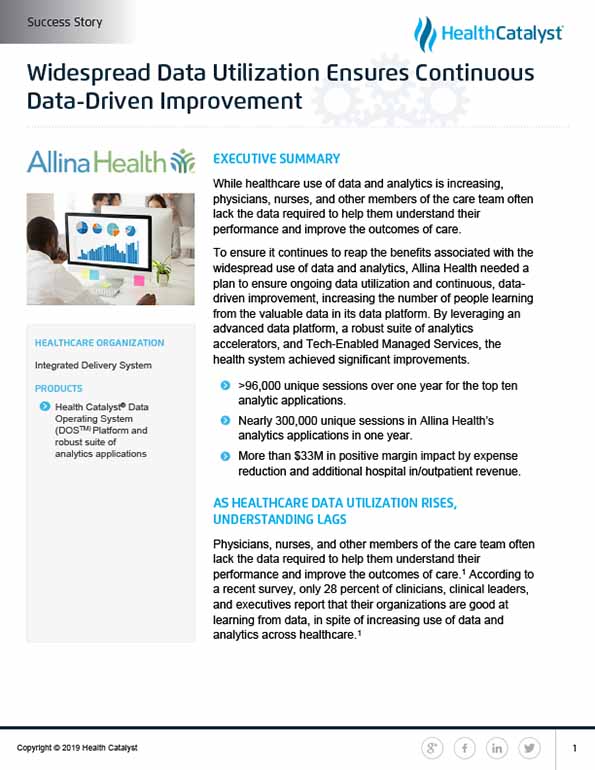Healthcare data and analytics usage is rising, but care team members often lack essential performance data. Allina Health developed a plan to ensure widespread data utilization and continuous improvement through its advanced data platform, a robust suite of analytics accelerators, and Tech-Enabled Managed Services, resulting in significant improvements.
While healthcare use of data and analytics is increasing, physicians, nurses, and other members of the care team often lack the data required to help them understand their performance and improve the outcomes of care.
To ensure it continues to reap the widespread use of data and analytics, Allina Health needed a plan to ensure ongoing data utilization and continuous, data-driven improvement, increasing the number of people learning from the valuable data in its data platform. By leveraging an advanced data platform, a robust suite of analytics accelerators, and Tech-Enabled Managed Services, the health system observed significant improvements.
Physicians, nurses, and other members of the care team often lack the data required to help them understand their performance and improve the outcomes of care.1 According to a recent survey, only 28 percent of clinicians, clinical leaders, and executives report that their organizations are good at learning from data, in spite of increasing use of data and analytics across healthcare.1
A not-for-profit health system, Allina Health is dedicated to the prevention and treatment of illness and enhancing the greater health of individuals, families, and communities throughout Minnesota and western Wisconsin.
Allina Health understands the power of integrated data and analytics to improve clinical, financial, and operational improvements. The organization has successfully reduced the cost of delivering care, while improving patient outcomes, and provider satisfaction.
To ensure it continues to reap the benefits associated with the widespread use of data and analytics, Allina Health needed a plan to ensure ongoing healthcare data utilization and continuous, data-driven improvement. It aimed to increase the number of people learning from the valuable data in its data platform.
Support for broad-based use of data and analytics at Allina Health starts at the top, with strong support from the CEO and senior leadership team, who understand the importance of integrated data in driving clinical, operational, and financial improvements. Allina Health empowers employees, clinicians, and affiliates to deliver the best care at the best value for the community and at the best cost of production for the communities it serves. The following services, practices, and processes help Allina Health gain insight from data:
Allina Health uses analytics to proactively monitor utilization and uses this information to further influence analytics adoption. Allina Health’s Usage Monitor Analytics Accelerator allows the organization to actively monitor the number of users for each of its analytics applications. The organization can easily identify top ten users and the number of sessions; users per month per application, including usage by physical location, title, week, and hour; and can contact users when tools are updated.
Ongoing, proactive monitoring of usage—and intervening when usage is low—allows Allina Health to maximize its analytics adoption and further generate an environment of continuous improvement, while supporting Allina Health in prioritizing improvement requests. For example, using the Report Usage Monitor Analytics Accelerator, the organization identified that usage of an open-access scheduling application was less than expected.
Leaders reached out to the users of the self-scheduling application about why utilization was lower than expected; this insight helped reconcile the barriers to use and improve the use of the self-scheduling application. Allina Health uses the analytics accelerators to assist with prioritization requests, first allocating resources to improve the applications and reports with the highest number of users, and sunsetting applications and reports that are no longer needed, decreasing its technical debt.
Many years into its analytics journey, Allina Health continues to increase its organizational use of data to drive operations, realizing significant improvements:
With ready access to data via the data platform, Allina Health’s data-driven improvement culture is helping the organization deliver the best care, at the best value for the community, and at the best cost of production for the communities it serves. Select results include the following:
“Unleashing the data at Allina Health has been key to increasing organizational efficiency, reducing costs, and improving outcomes for our patients. Using data and analytics, Allina Health has saved millions of dollars and improved our ability to deliver on our mission of enhancing the greater health of individuals, families, and communities throughout Minnesota and western Wisconsin.”
– Jonathan Shoemaker, Senior Vice President, Chief Information Officer, Allina Health
Allina Health plans to continue its analytics adoption journey and will further democratize data, continually improving the access and use of data to improve outcomes for the communities it serves.


